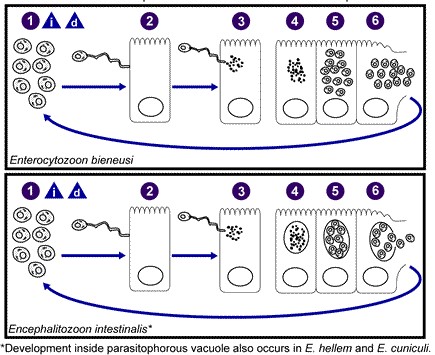
No higher resolution available.

|
This image was uploaded to the shared "Image Pool" and is usable on any CreationWiki site.
Please go to the Pool to edit its description.
|
Summary
The life cycle of Microsporidia.
The infective form of microsporidia is the resistant spore and it can survive for a long time in the environment The number 1. The spore extrudes its polar tubule and infects the host cell The number 2. The spore injects the infective sporoplasm into the eukaryotic host cell through the polar tubule The number 3. Inside the cell, the sporoplasm undergoes extensive multiplication either by merogony (binary fission) or schizogony (multiple fission) The number 4. This development can occur either in direct contact with the host cell cytoplasm (e.g., E. bieneusi) or inside a vacuole termed parasitophorous vacuole (e.g., E. intestinalis). Either free in the cytoplasm or inside a parasitophorous vacuole, microsporidia develop by sporogony to mature spores The number 5. During sporogony, a thick wall is formed around the spore, which provides resistance to adverse environmental conditions. When the spores increase in number and completely fill the host cell cytoplasm, the cell membrane is disrupted and releases the spores to the surroundings The number 6. These free mature spores can infect new cells thus continuing the cycle.
Copyright status:
Originally published by Centers for Disease Control
Source:
http://www.cdc.gov/dpdx/microsporidiosis/
File history
Click on a date/time to view the file as it appeared at that time.
| Date/Time | Thumbnail | Dimensions | User | Comment |
|---|
| current | 03:31, 23 May 2016 |  | 435 × 355 (93 KB) | Muk R11ze | The life cycle of Microsporidia. |
File usage
The following page uses this file:
This file contains additional information, probably added from the digital camera or scanner used to create or digitize it.
If the file has been modified from its original state, some details may not fully reflect the modified file.

